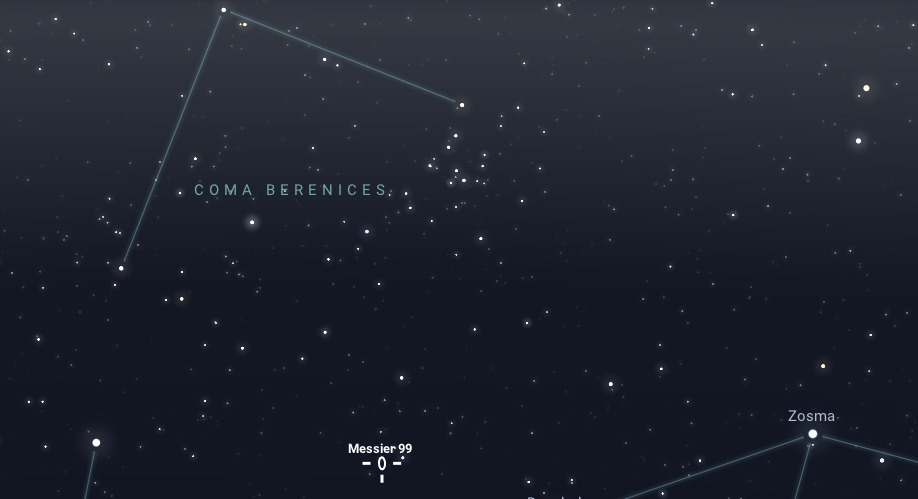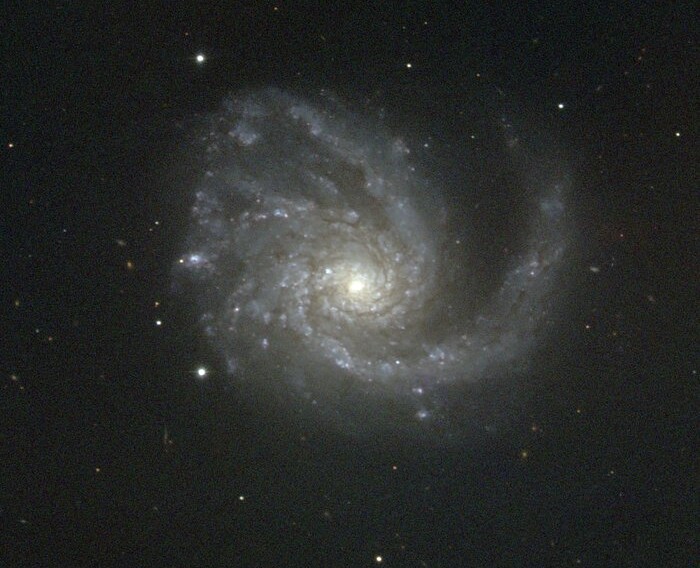M99, also known as NGC 4254, is a prominent spiral galaxy situated in the constellation Coma Berenices. This galaxy is classified as an SA(s)c type, indicating it is an unbarred spiral galaxy with loosely wound arms. M99 shines with an apparent magnitude of 9.8, making it a faint object in the night sky, observable with modest amateur telescopes. Located approximately 50 to 60 million light-years away from Earth, M99 is part of the Virgo Cluster of galaxies.
Discovery and Observation
M99 was discovered by the French astronomer Pierre Méchain on March 15, 1781. Shortly after its discovery, it was catalogued by Charles Messier in his famous catalog of comet-like objects. This catalog, originally intended to help astronomers avoid mistaking these objects for comets, has since become one of the most well-known lists of deep-sky objects. M99’s discovery in the 18th century highlighted the advancements in telescope technology and the growing interest in cataloging celestial objects beyond our solar system.
Characteristics
M99 is a classic example of a grand design spiral galaxy, characterized by its well-defined and prominent spiral arms. These arms are rich in young, hot stars and regions of active star formation, giving the galaxy a distinct and picturesque appearance. M99 spans roughly 85,000 light-years in diameter, making it slightly smaller than our own Milky Way galaxy. It is receding from us with a radial velocity of about 2,374 km/s. The galaxy’s structure and kinematics provide valuable data for understanding the dynamics of spiral galaxies.
Notable Features
One of the most striking features of M99 is its active star-forming regions. The spiral arms host numerous young, blue stars and pinkish regions indicative of hydrogen gas clouds where new stars are born. The galaxy has also been the site of several supernovae, with notable examples including SN 1967H, SN 1972Q, and SN 1986I. These supernovae provide key insights into the life cycles of stars and the chemical enrichment of galaxies. Additionally, the galaxy’s asymmetry hints at past gravitational interactions, possibly with other members of the Virgo Cluster, making it a subject of interest for studying galactic interactions.

Astrophysical Research
Research on M99 often focuses on its morphology and the dynamics within the Virgo Cluster. The galaxy’s asymmetrical shape and uneven distribution of stars and gas are likely influenced by tidal interactions with nearby galaxies or the cluster’s gravitational potential. Studying these features helps astronomers understand the environmental effects on galaxy evolution. Additionally, M99’s active star-forming regions are of particular interest for investigating the processes of star formation and the influence of galactic dynamics on these regions.
Additional Facts
M99 is also known by its New General Catalogue (NGC) number, NGC 4254, a designation used by astronomers to reference it in various astronomical databases. It is located near several other notable Messier objects within the Virgo Cluster, including M98, M100, and M87, the latter being famous for its supermassive black hole. The proximity of these objects within the cluster provides a rich field for observational studies and comparative analyses of different types of galaxies.
Imagery
Images of M99, particularly those captured by advanced observatories such as the Hubble Space Telescope, reveal its stunning spiral structure with high clarity. The blue hues in the spiral arms are due to the presence of young, hot stars, while the reddish and pink regions highlight areas of intense star formation. These images not only offer aesthetic pleasure but also serve as vital tools for studying the physical properties and processes within the galaxy. Detailed imagery helps astronomers map out star formation regions, analyze the distribution of different stellar populations, and investigate the effects of environmental factors on the galaxy’s morphology.
Significance
As one of the brighter spiral galaxies in the Virgo Cluster, M99 plays a significant role in the study of galaxy formation and evolution. Its well-defined spiral arms and active star-forming regions provide a laboratory for understanding the mechanisms of star birth and the influence of galactic environments on these processes. Moreover, the galaxy’s interactions with its cluster neighbours offer insights into the complex gravitational dynamics that shape galaxies over time. M99’s combination of beauty and scientific importance makes it a key object of interest in both observational astronomy and theoretical research.
Observation
M99 is best viewed during the spring months, with May being an optimal time when the constellation Coma Berenices is prominently placed in the night sky. While M99 can be detected as a faint patch of light through small telescopes, resolving its detailed spiral structure requires larger telescopes or long-exposure astrophotography. Observers with moderate to large telescopes can enjoy a more detailed view of its spiral arms and star-forming regions, making it a rewarding target for amateur astronomers.




